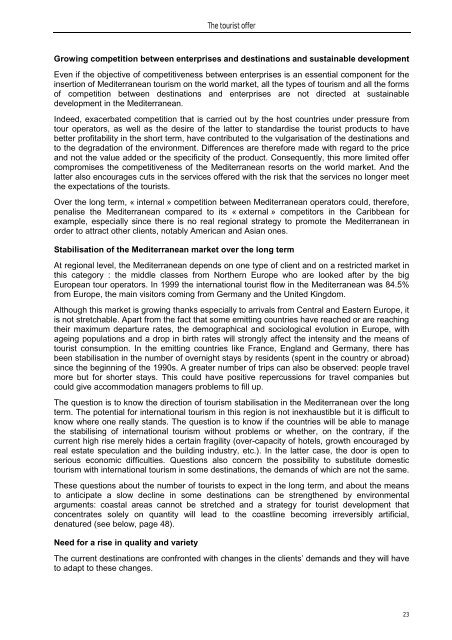dossier sur le tourisme et le développement durable
dossier sur le tourisme et le développement durable
dossier sur le tourisme et le développement durable
Create successful ePaper yourself
Turn your PDF publications into a flip-book with our unique Google optimized e-Paper software.
The tourist offer<br />
Growing comp<strong>et</strong>ition b<strong>et</strong>ween enterprises and destinations and sustainab<strong>le</strong> development<br />
Even if the objective of comp<strong>et</strong>itiveness b<strong>et</strong>ween enterprises is an essential component for the<br />
insertion of Mediterranean tourism on the world mark<strong>et</strong>, all the types of tourism and all the forms<br />
of comp<strong>et</strong>ition b<strong>et</strong>ween destinations and enterprises are not directed at sustainab<strong>le</strong><br />
development in the Mediterranean.<br />
Indeed, exacerbated comp<strong>et</strong>ition that is carried out by the host countries under pres<strong>sur</strong>e from<br />
tour operators, as well as the desire of the latter to standardise the tourist products to have<br />
b<strong>et</strong>ter profitability in the short term, have contributed to the vulgarisation of the destinations and<br />
to the degradation of the environment. Differences are therefore made with regard to the price<br />
and not the value added or the specificity of the product. Consequently, this more limited offer<br />
compromises the comp<strong>et</strong>itiveness of the Mediterranean resorts on the world mark<strong>et</strong>. And the<br />
latter also encourages cuts in the services offered with the risk that the services no longer me<strong>et</strong><br />
the expectations of the tourists.<br />
Over the long term, « internal » comp<strong>et</strong>ition b<strong>et</strong>ween Mediterranean operators could, therefore,<br />
penalise the Mediterranean compared to its « external » comp<strong>et</strong>itors in the Caribbean for<br />
examp<strong>le</strong>, especially since there is no real regional strategy to promote the Mediterranean in<br />
order to attract other clients, notably American and Asian ones.<br />
Stabilisation of the Mediterranean mark<strong>et</strong> over the long term<br />
At regional <strong>le</strong>vel, the Mediterranean depends on one type of client and on a restricted mark<strong>et</strong> in<br />
this category : the midd<strong>le</strong> classes from Northern Europe who are looked after by the big<br />
European tour operators. In 1999 the international tourist flow in the Mediterranean was 84.5%<br />
from Europe, the main visitors coming from Germany and the United Kingdom.<br />
Although this mark<strong>et</strong> is growing thanks especially to arrivals from Central and Eastern Europe, it<br />
is not str<strong>et</strong>chab<strong>le</strong>. Apart from the fact that some emitting countries have reached or are reaching<br />
their maximum departure rates, the demographical and sociological evolution in Europe, with<br />
ageing populations and a drop in birth rates will strongly affect the intensity and the means of<br />
tourist consumption. In the emitting countries like France, England and Germany, there has<br />
been stabilisation in the number of overnight stays by residents (spent in the country or abroad)<br />
since the beginning of the 1990s. A greater number of trips can also be observed: peop<strong>le</strong> travel<br />
more but for shorter stays. This could have positive repercussions for travel companies but<br />
could give accommodation managers prob<strong>le</strong>ms to fill up.<br />
The question is to know the direction of tourism stabilisation in the Mediterranean over the long<br />
term. The potential for international tourism in this region is not inexhaustib<strong>le</strong> but it is difficult to<br />
know where one really stands. The question is to know if the countries will be ab<strong>le</strong> to manage<br />
the stabilising of international tourism without prob<strong>le</strong>ms or wh<strong>et</strong>her, on the contrary, if the<br />
current high rise merely hides a certain fragility (over-capacity of hotels, growth encouraged by<br />
real estate speculation and the building industry, <strong>et</strong>c.). In the latter case, the door is open to<br />
serious economic difficulties. Questions also concern the possibility to substitute domestic<br />
tourism with international tourism in some destinations, the demands of which are not the same.<br />
These questions about the number of tourists to expect in the long term, and about the means<br />
to anticipate a slow decline in some destinations can be strengthened by environmental<br />
arguments: coastal areas cannot be str<strong>et</strong>ched and a strategy for tourist development that<br />
concentrates so<strong>le</strong>ly on quantity will <strong>le</strong>ad to the coastline becoming irreversibly artificial,<br />
denatured (see below, page 48).<br />
Need for a rise in quality and vari<strong>et</strong>y<br />
The current destinations are confronted with changes in the clients’ demands and they will have<br />
to adapt to these changes.<br />
23
















